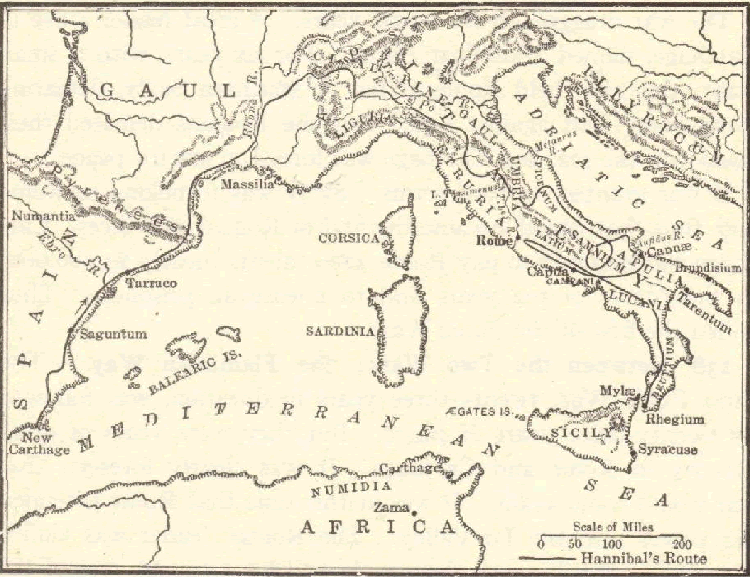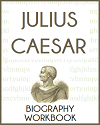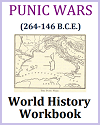Map of the Punic Wars: Ancient Rome and Carthage. This map illustrates Hannibal's route from Spain, along the Mediterranean, across the Alps, and through Italy. Click here to enlarge.
The Punic Wars were a series of three conflicts fought between the Roman Republic and the city-state of Carthage in North Africa, primarily in the 3rd and 2nd centuries B.C.E. These wars had a profound impact on the course of Western history, particularly the rise of Rome as a dominant Mediterranean power.
First Punic War (264-241 B.C.E.):
- Cause: The First Punic War began as a result of a territorial dispute in Sicily. Both Rome and Carthage sought control over the island.
- Key Events: This was primarily a naval war, with Rome building a formidable navy to challenge Carthaginian dominance at sea. The war included several naval battles, with Rome ultimately prevailing. The most famous of these battles was the Battle of Mylae.
- Outcome: The war ended with the Treaty of Lutatius in 241 B.C.E., in which Carthage ceded Sicily to Rome. This marked Rome's first significant overseas conquest and the beginning of its expansion beyond the Italian Peninsula.
Second Punic War (218-201 B.C.E.):
- Cause: The Second Punic War is most famous for the Carthaginian general Hannibal Barca's audacious crossing of the Alps to attack Rome. Hannibal's motivations were both strategic and a desire for revenge following the defeat in the First Punic War.
- Key Events: Hannibal's brilliant military tactics in Italy, including victories at the Battle of Cannae, made this war one of the most significant in ancient history. The Roman general Scipio Africanus later took the war to Carthage, culminating in the Battle of Zama, where Rome emerged victorious.
- Outcome: The Treaty of Zama in 201 B.C.E. marked the end of the Second Punic War. Carthage was forced to pay reparations, surrender its navy, and give up its overseas territories. Rome's power and influence grew significantly in the Mediterranean.
Third Punic War (149-146 B.C.E.):
- Cause: The Third Punic War began when Rome, under the pretext of Carthage violating its treaty obligations, besieged and ultimately destroyed the city of Carthage.
- Key Events: The war consisted mainly of the siege and destruction of Carthage. The Roman statesman Cato the Elder famously advocated for the city's complete destruction.
- Outcome: In 146 B.C.E., Carthage was captured and systematically destroyed by the Romans. The city was burned, and its territory was annexed as a Roman province. The end of the Third Punic War marked the complete annihilation of the once-mighty Carthaginian civilization.
The Punic Wars left an enduring legacy. Rome's territorial expansion and wealth from these wars contributed to the decline of the Roman Republic and the rise of the Roman Empire. The conflicts also influenced Rome's military strategies and the development of its navy. Additionally, the Punic Wars have been the subject of numerous historical accounts, making them a prominent part of ancient history.
|















